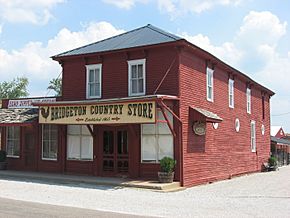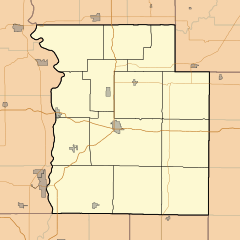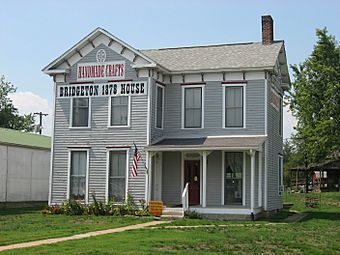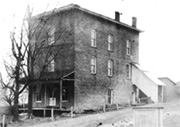Bridgeton, Indiana facts for kids
Quick facts for kids
Bridgeton, Indiana
|
|
|---|---|

Bridgeton Country Store est. 1865
|
|
| Nicknames:
Lockwood Mills, Sodom
|
|

Parke County's location in Indiana
|
|
| Country | United States |
| State | Indiana |
| County | Parke |
| Township | Raccoon |
| Elevation | 564 ft (172 m) |
| Time zone | UTC-5 (Eastern (EST)) |
| • Summer (DST) | UTC-5 (EST) |
| ZIP code |
47874
|
| Area code(s) | 765 |
| GNIS feature ID | 2830488 |
Bridgeton is a small community in Parke County, Indiana. It is famous for its historic covered bridge. This bridge was sadly destroyed by fire in 2005. But don't worry! A new bridge, looking just like the old one, was built in 2006.
Contents
Bridgeton's Story
Around 1823, a sawmill was built here by Joseph Lockwood and Issac J. Sillman. It was used to cut wood. Later, a special stone was added to grind corn and wheat into flour. This made the mill a very important place for local farmers.
The mill changed owners several times. In 1845, the mill and a nearby distillery (a place that makes spirits) burned down. But the community needed a mill. So, by 1848, the Owsley brothers and William Bean built a new log mill.
That same year, a log bridge was built over Big Raccoon Creek. This bridge made it much easier for farmers to bring their crops to the mill.
How Bridgeton Got Its Name
Bridgeton was first called Lockwood Mills. This was after Joseph Lockwood, who helped build the first mill. Later, it became known as Sodom. This was because the mill was a busy social center. People would gather there to do business and share news. It was a very lively place!
In 1849, the village applied for a post office. The name was then changed to Bridgeton. This name likely came from the new bridge that was so important to the town.
Bridgeton Historic District
The Bridgeton Historic District is a special area in Bridgeton. It protects important old buildings. One of its most famous buildings is the Bridgeton Mill. This mill is known as the oldest continuously working mill west of the Allegheny Mountains.
The Famous Bridgeton Mill
Ralph Sprague bought the mill in 1862. In 1868, another fire destroyed this mill. But Sprague decided to rebuild it. The mill you see today was built in 1871. It is a very important historical building in the area.
The new mill, built in 1871, was very modern for its time. It had large grinding stones for animal feed. It also had special roller mills for making flour from wheat. The mill was built with a strong stone foundation. It had three stories and a sloped roof. Water from the creek would flow under the mill. This water powered turbines that made the mill machinery work.
Daniel Webster bought the mill in 1882. He made it even more modern. He replaced the old grinding stones with new steel roller mills. Under his care, the mill became very successful. It was known as the Bridgeton Roller Mills.
Farmers used to pay for milling services with a part of their grain. During Webster's time, farmers would trade their wheat or corn for flour or meal. The mill could produce a lot of flour each day. It sold flour under different brand names like Family and Snowdrift.
After Daniel Webster passed away in 1895, the mill changed hands again. In 1906, a new owner, P.T. Winney, installed generators. This allowed the mill to provide electricity for the town until 1913.
Over the years, the mill continued to operate. In 1938, it was changed to a feed mill. This meant it mostly ground grain for animal feed. In 1940, the Weise family bought the mill. They ran it as the Weise Milling Company.
As water levels in the creek dropped, the Weises changed the mill to run on electricity. In 1969, daily milling stopped. But the mill still sold products to visitors. In 1972, the Weises brought back some old grinding stones. They put them back in the mill.
Today, Mike and Karen Roe own the mill. They continue to operate it. They use old recipes from the Weise family. The mill is open for visitors from April to December.
The "1878 House"
Ralph Sprague, who owned the mill, built this beautiful house in 1878. It is a two-story wooden house. It has a classic design with Italianate style decorations. The house has a stone foundation and wooden siding. You can see "1878" vents on the front and side of the house.
Sprague lived here until 1882. Then, Daniel Webster, the new mill owner, bought the house. The Webster family lived there until 1899. After some time, the house became a gift shop in 1980. It is now known locally as the "1878 House."
Masonic Lodge 169
In 1869, the Freemasons built a three-story building in Bridgeton. This was their meeting place, called a Masonic Lodge. In 1913, the third floor was removed after a fire. This Lodge is the oldest building in Bridgeton.
It is also one of the last "Masonic Moon lodges" in the country. Back then, roads were not very good. So, meetings were held around the time of the full moon. This made it safer and easier for members to travel at night. The moonlight helped them see their way.




